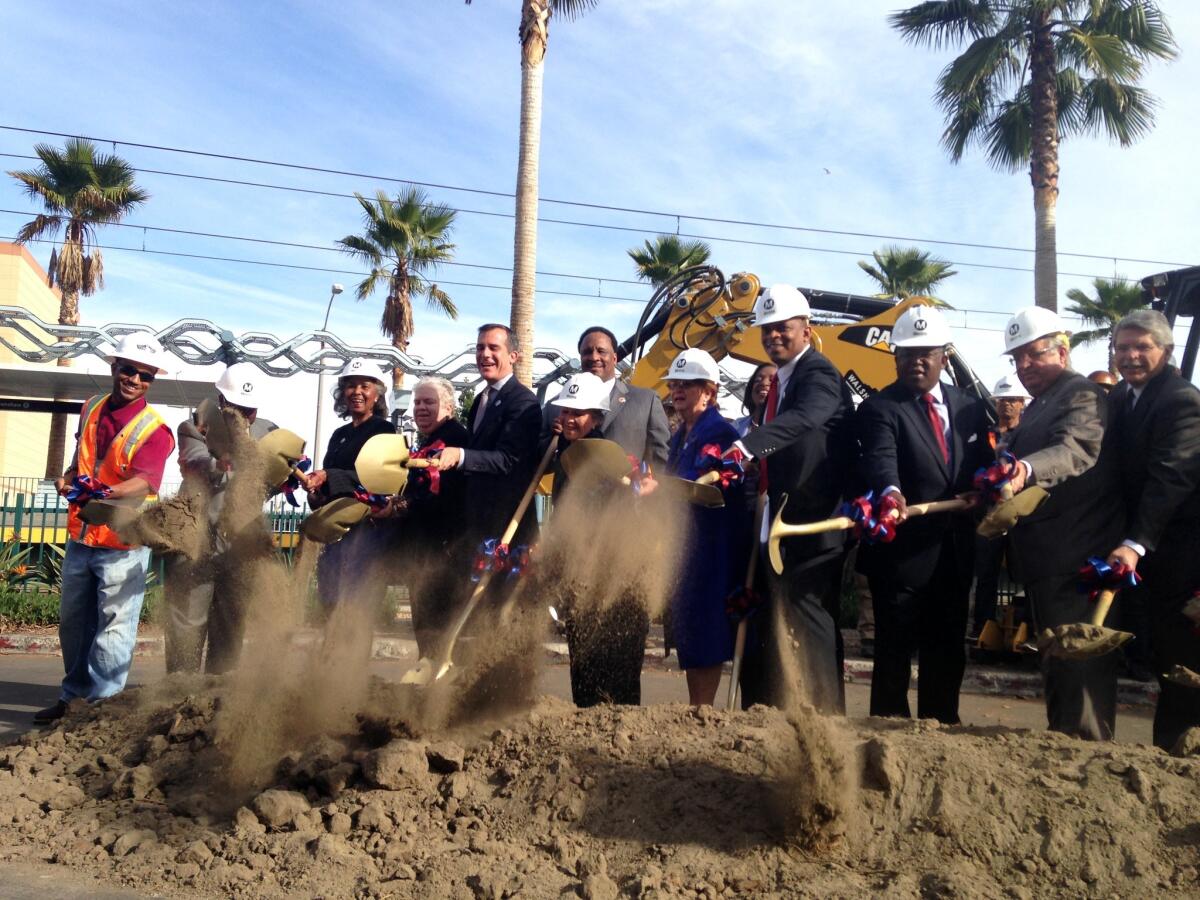Metro breaks ground on $2-billion Crenshaw light-rail line

Officials celebrated the groundbreaking Tuesday for the $2.06-billion north-south Crenshaw Line that will connect the Mid-City Expo Line with the South Bay’s Green Line.
“This is a day that Angelenos deserve, a great day for L.A., a day to move America forward,” Los Angeles Mayor Eric Garcetti said.
The Department of Transportation also announced Tuesday that the project would receive a $545.9-million loan. The project also is expected to receive about $130 million in other federal transportation funds, according to a statement.
LIVE CHAT: Discuss $2-billion Crenshaw line at 9 a.m. Wednesday“This is a partnership -- a local, state and federal partnership,” said U.S. Transportation Secretary Anthony Foxx.
But just outside the tent, where elected and transportation officials gathered for the groundbreaking, about a dozen construction workers and local residents protested the segment of light-rail line that they said would marginalize their community.
The line is designed to run at ground level from 48th to 60th streets along Crenshaw Boulevard. Residents and activists fought for that segment of the line to be put underground; Metro said tunneling would be too expensive.
“We don’t want this to divide our community,” said Audrey Reems, who runs a Montessori preschool at 48th Street and Crenshaw. Next to her, a woman held a sign that said, “It’s not over ‘til it’s under.”
A group of employees from the Young Black Contractors Assn. of South L.A., Inc. said they were concerned that their crew wouldn’t get any work on the project.
“We don’t mind leaving our area for jobs,” said Jap Willins, a construction worker with the group. “But if work is here, we want a piece of it.”
Metro has committed to hiring 40% economically disadvantaged workers on the project. Metro will find those workers and maintain those quotas mostly by reaching out through the building and trade unions.
Garcetti said he, City Councilman Bernard Parks and others are committed to making sure local businesses survive the construction, especially in Leimert Park.
“The [line] will be a lasting economic catalyst,” Garcetti said. “We are committed to making sure that businesses remain in local hands.”
When it opens, slated for 2019, it will pass 1.5 miles east of the LAX terminals, with a stop at Century and Aviation boulevards. It will not have an LAX connection, other than shuttles, for up to nine more years, depending on how a series of design and financing issues are resolved.
Los Angeles World Airports and Metropolitan Transportation Authority officials are considering a direct extension of the light-rail system or a separate people-mover system that would circulate inside the airport. A decision on a route and the type of system that would be built is expected late this year.
The Crenshaw Line will run east of the airport because planners can use a right-of-way from an abandoned freight train line. Preliminary Metro studies have shown that ridership would be highest if the airport link did not require passengers to make an additional transfer to get to the terminal.
The project is partially funded by Measure R, the half-cent sales tax Los Angeles County voters passed in 2008. When major construction begins, the Crenshaw Line will be one of five simultaneous significant rail projects in the county.
“Isn’t it wonderful to talk about something good in our communities? I am so pleased,” said U.S. Rep. Maxine Waters (D-Los Angeles).
The Crenshaw Line will include a station at Leimert Park, hailed as South L.A.’s answer to Gold Line stations in Chinatown, Little Tokyo and Mariachi Plaza.
The plan originally didn’t have a Leimert Park station, and it took a two-year fight by community members to get it approved.
The connectivity the light rail will bring could change the future of Leimert Park Village, considered the hub of African American business and culture in Southern California, residents said. The neighborhood’s main street is lined with shops and cafes, as well as one of the last black-centric bookstores in the region.
Twitter: @laura_nelson
laura.nelson@latimes.com
More to Read
Sign up for Essential California
The most important California stories and recommendations in your inbox every morning.
You may occasionally receive promotional content from the Los Angeles Times.











